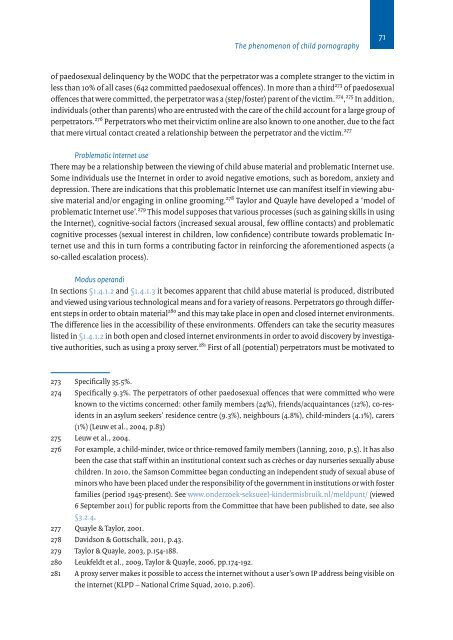Child Pornography - Home | National Rapporteur on Trafficking in ...
Child Pornography - Home | National Rapporteur on Trafficking in ...
Child Pornography - Home | National Rapporteur on Trafficking in ...
Create successful ePaper yourself
Turn your PDF publications into a flip-book with our unique Google optimized e-Paper software.
The phenomen<strong>on</strong> of child pornography<br />
of paedosexual del<strong>in</strong>quency by the WODC that the perpetrator was a complete stranger to the victim <strong>in</strong><br />
less than 10% of all cases (642 committed paedosexual offences). In more than a third 273 of paedosexual<br />
offences that were committed, the perpetrator was a (step/foster) parent of the victim. 274 , 275 In additi<strong>on</strong>,<br />
<strong>in</strong>dividuals (other than parents) who are entrusted with the care of the child account for a large group of<br />
perpetrators. 276 Perpetrators who met their victim <strong>on</strong>l<strong>in</strong>e are also known to <strong>on</strong>e another, due to the fact<br />
that mere virtual c<strong>on</strong>tact created a relati<strong>on</strong>ship between the perpetrator and the victim. 277<br />
Problematic Internet use<br />
There may be a relati<strong>on</strong>ship between the view<strong>in</strong>g of child abuse material and problematic Internet use.<br />
Some <strong>in</strong>dividuals use the Internet <strong>in</strong> order to avoid negative emoti<strong>on</strong>s, such as boredom, anxiety and<br />
depressi<strong>on</strong>. There are <strong>in</strong>dicati<strong>on</strong>s that this problematic Internet use can manifest itself <strong>in</strong> view<strong>in</strong>g abusive<br />
material and/or engag<strong>in</strong>g <strong>in</strong> <strong>on</strong>l<strong>in</strong>e groom<strong>in</strong>g. 278 Taylor and Quayle have developed a ‘model of<br />
problematic Internet use’. 279 This model supposes that various processes (such as ga<strong>in</strong><strong>in</strong>g skills <strong>in</strong> us<strong>in</strong>g<br />
the Internet), cognitive-social factors (<strong>in</strong>creased sexual arousal, few offl<strong>in</strong>e c<strong>on</strong>tacts) and problematic<br />
cognitive processes (sexual <strong>in</strong>terest <strong>in</strong> children, low c<strong>on</strong>fidence) c<strong>on</strong>tribute towards problematic Internet<br />
use and this <strong>in</strong> turn forms a c<strong>on</strong>tribut<strong>in</strong>g factor <strong>in</strong> re<strong>in</strong>forc<strong>in</strong>g the aforementi<strong>on</strong>ed aspects (a<br />
so-called escalati<strong>on</strong> process).<br />
Modus operandi<br />
In secti<strong>on</strong>s §1.4.1.2 and §1.4.1.3 it becomes apparent that child abuse material is produced, distributed<br />
and viewed us<strong>in</strong>g various technological means and for a variety of reas<strong>on</strong>s. Perpetrators go through different<br />
steps <strong>in</strong> order to obta<strong>in</strong> material 280 and this may take place <strong>in</strong> open and closed <strong>in</strong>ternet envir<strong>on</strong>ments.<br />
The difference lies <strong>in</strong> the accessibility of these envir<strong>on</strong>ments. Offenders can take the security measures<br />
listed <strong>in</strong> §1.4.1.2 <strong>in</strong> both open and closed <strong>in</strong>ternet envir<strong>on</strong>ments <strong>in</strong> order to avoid discovery by <strong>in</strong>vestigative<br />
authorities, such as us<strong>in</strong>g a proxy server. 281 First of all (potential) perpetrators must be motivated to<br />
273 Specifically 35.5%.<br />
274 Specifically 9.3%. The perpetrators of other paedosexual offences that were committed who were<br />
known to the victims c<strong>on</strong>cerned: other family members (24%), friends/acqua<strong>in</strong>tances (12%), co-residents<br />
<strong>in</strong> an asylum seekers’ residence centre (9.3%), neighbours (4.8%), child-m<strong>in</strong>ders (4.1%), carers<br />
(1%) (Leuw et al., 2004, p.83)<br />
275 Leuw et al., 2004.<br />
276 For example, a child-m<strong>in</strong>der, twice or thrice-removed family members (Lann<strong>in</strong>g, 2010, p.5). It has also<br />
been the case that staff with<strong>in</strong> an <strong>in</strong>stituti<strong>on</strong>al c<strong>on</strong>text such as crèches or day nurseries sexually abuse<br />
children. In 2010, the Sams<strong>on</strong> Committee began c<strong>on</strong>duct<strong>in</strong>g an <strong>in</strong>dependent study of sexual abuse of<br />
m<strong>in</strong>ors who have been placed under the resp<strong>on</strong>sibility of the government <strong>in</strong> <strong>in</strong>stituti<strong>on</strong>s or with foster<br />
families (period 1945-present). See www.<strong>on</strong>derzoek-seksueel-k<strong>in</strong>dermisbruik.nl/meldpunt/ (viewed<br />
6 September 2011) for public reports from the Committee that have been published to date, see also<br />
§3.2.4.<br />
277 Quayle & Taylor, 2001.<br />
278 Davids<strong>on</strong> & Gottschalk, 2011, p.43.<br />
279 Taylor & Quayle, 2003, p.154-188.<br />
280 Leukfeldt et al., 2009, Taylor & Quayle, 2006, pp.174-192.<br />
281 A proxy server makes it possible to access the <strong>in</strong>ternet without a user’s own IP address be<strong>in</strong>g visible <strong>on</strong><br />
the <strong>in</strong>ternet (KLPD – <str<strong>on</strong>g>Nati<strong>on</strong>al</str<strong>on</strong>g> Crime Squad, 2010, p.206).<br />
71


